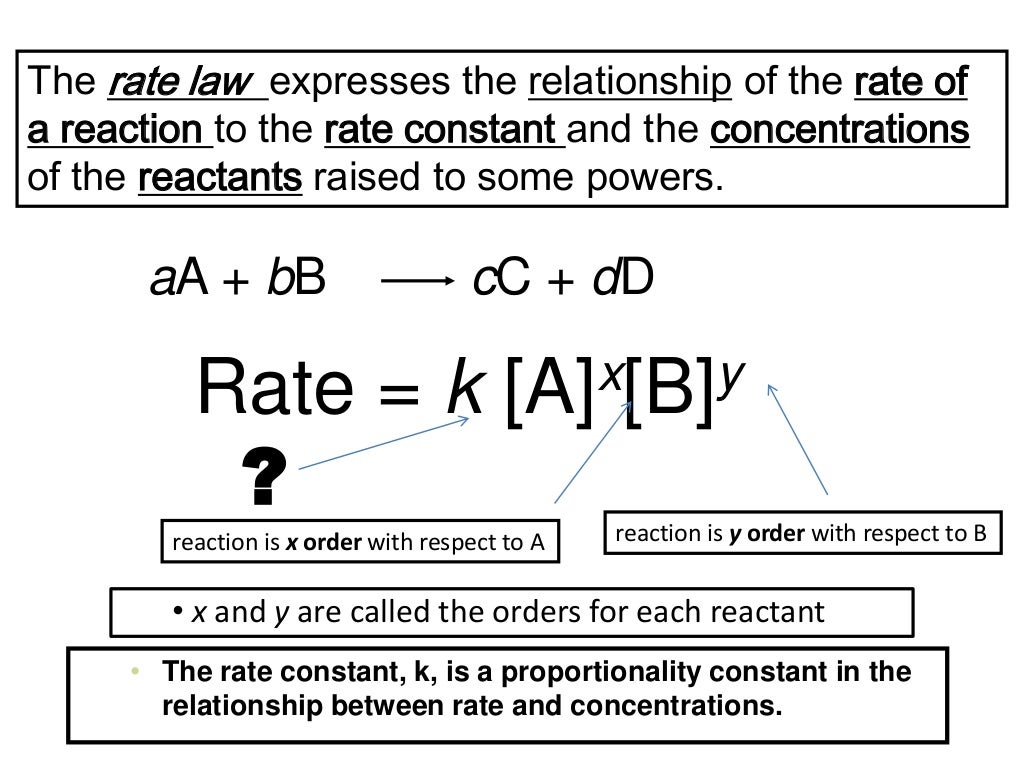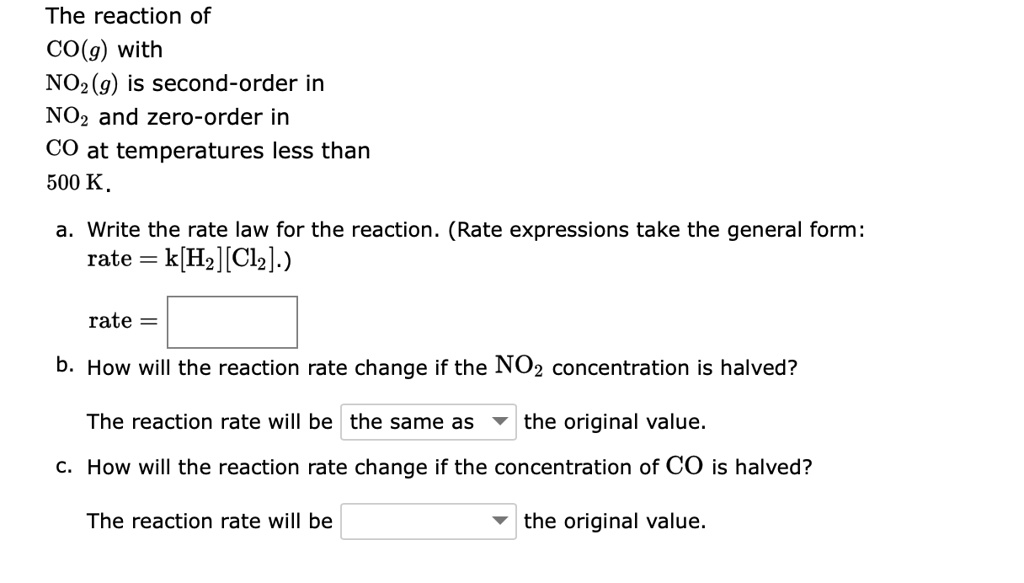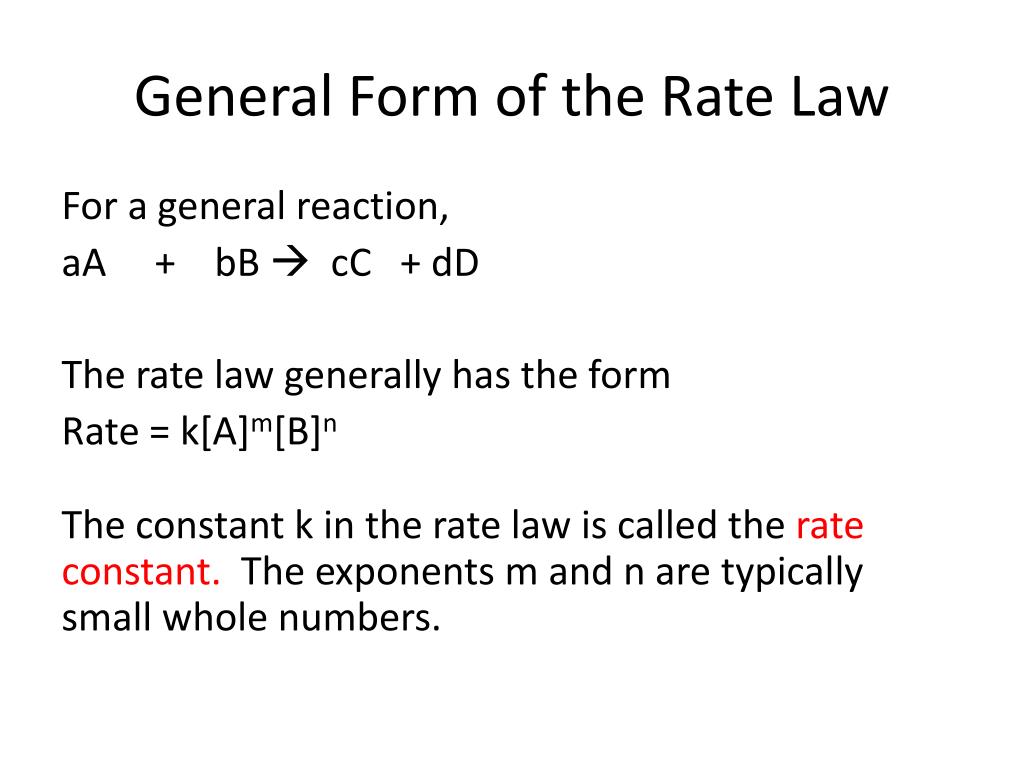General Form Of A Rate Law
General Form Of A Rate Law - The general rate law for the reaction is given in equation \(\ref{14.4.11}\). The rate law (also known as the rate equation) for a chemical reaction is an expression that provides a. Rate laws or rate equations are mathematical expressions that describe the relationship between the rate of a chemical. We can obtain m or n directly by using a proportion of the rate laws for. What is the rate law? Rate laws or rate equations are mathematical expressions that describe the relationship between the rate of a chemical reaction and the.
Rate laws or rate equations are mathematical expressions that describe the relationship between the rate of a chemical reaction and the. What is the rate law? The rate law (also known as the rate equation) for a chemical reaction is an expression that provides a. We can obtain m or n directly by using a proportion of the rate laws for. Rate laws or rate equations are mathematical expressions that describe the relationship between the rate of a chemical. The general rate law for the reaction is given in equation \(\ref{14.4.11}\).
The rate law (also known as the rate equation) for a chemical reaction is an expression that provides a. Rate laws or rate equations are mathematical expressions that describe the relationship between the rate of a chemical. Rate laws or rate equations are mathematical expressions that describe the relationship between the rate of a chemical reaction and the. The general rate law for the reaction is given in equation \(\ref{14.4.11}\). What is the rate law? We can obtain m or n directly by using a proportion of the rate laws for.
Rate Law Determin worksheets for general chemistry class. 2014 How
What is the rate law? Rate laws or rate equations are mathematical expressions that describe the relationship between the rate of a chemical reaction and the. We can obtain m or n directly by using a proportion of the rate laws for. The rate law (also known as the rate equation) for a chemical reaction is an expression that provides.
8.1 rate law
The general rate law for the reaction is given in equation \(\ref{14.4.11}\). We can obtain m or n directly by using a proportion of the rate laws for. Rate laws or rate equations are mathematical expressions that describe the relationship between the rate of a chemical. Rate laws or rate equations are mathematical expressions that describe the relationship between the.
A Rate Law and Activation Energy Lab Report Anthony Parafati
Rate laws or rate equations are mathematical expressions that describe the relationship between the rate of a chemical. Rate laws or rate equations are mathematical expressions that describe the relationship between the rate of a chemical reaction and the. The general rate law for the reaction is given in equation \(\ref{14.4.11}\). We can obtain m or n directly by using.
13.3 Integrated Rate Laws YouTube
Rate laws or rate equations are mathematical expressions that describe the relationship between the rate of a chemical. The rate law (also known as the rate equation) for a chemical reaction is an expression that provides a. We can obtain m or n directly by using a proportion of the rate laws for. Rate laws or rate equations are mathematical.
Differential and Integral Forms of Rate Law💥 Chemical
Rate laws or rate equations are mathematical expressions that describe the relationship between the rate of a chemical. The rate law (also known as the rate equation) for a chemical reaction is an expression that provides a. The general rate law for the reaction is given in equation \(\ref{14.4.11}\). What is the rate law? We can obtain m or n.
03 08 1st order integrated rate law equation YouTube
What is the rate law? Rate laws or rate equations are mathematical expressions that describe the relationship between the rate of a chemical reaction and the. The general rate law for the reaction is given in equation \(\ref{14.4.11}\). The rate law (also known as the rate equation) for a chemical reaction is an expression that provides a. We can obtain.
How to Write a Rate Law YouTube
Rate laws or rate equations are mathematical expressions that describe the relationship between the rate of a chemical reaction and the. Rate laws or rate equations are mathematical expressions that describe the relationship between the rate of a chemical. The rate law (also known as the rate equation) for a chemical reaction is an expression that provides a. What is.
Rate law postlab Rate law lab report with graphs and Discussion
The rate law (also known as the rate equation) for a chemical reaction is an expression that provides a. What is the rate law? Rate laws or rate equations are mathematical expressions that describe the relationship between the rate of a chemical reaction and the. We can obtain m or n directly by using a proportion of the rate laws.
SOLVED The reaction of CO(g) with NO2(g) is secondorder in NO2 and
What is the rate law? Rate laws or rate equations are mathematical expressions that describe the relationship between the rate of a chemical. The general rate law for the reaction is given in equation \(\ref{14.4.11}\). The rate law (also known as the rate equation) for a chemical reaction is an expression that provides a. Rate laws or rate equations are.
PPT The Rate Law PowerPoint Presentation, free download ID5857354
Rate laws or rate equations are mathematical expressions that describe the relationship between the rate of a chemical reaction and the. Rate laws or rate equations are mathematical expressions that describe the relationship between the rate of a chemical. What is the rate law? The rate law (also known as the rate equation) for a chemical reaction is an expression.
Rate Laws Or Rate Equations Are Mathematical Expressions That Describe The Relationship Between The Rate Of A Chemical Reaction And The.
What is the rate law? The rate law (also known as the rate equation) for a chemical reaction is an expression that provides a. We can obtain m or n directly by using a proportion of the rate laws for. Rate laws or rate equations are mathematical expressions that describe the relationship between the rate of a chemical.









